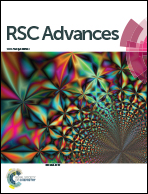Hierarchically nanostructured hydroxyapatite microspheres as drug delivery carriers and their effects on cell viability
Abstract
Hydroxyapatite microspheres (HAMSs) were fabricated via hydrothermal synthesis using propionamide (PA) as a pH-adjusting agent and trisodium citrate (TSC) as a regulating agent. Scanning electron microscopy (SEM) images indicated that the microspheres possessed well-defined 3D nanostructures constructed by nanoplates as building blocks. In vitro cell tests demonstrated that the HAMSs with or without heat treatment were able to promote the proliferation of mouse bone mesenchymal stem cells (mBMSCs). Gentamicin sulphate (GS), an anti-inflammatory, was successfully loaded in the HAMS particles at a distinctively high loading efficiency of approximately 87%. The resultant HAMS-GS delivery systems displayed a sustained release property, and the release of GS from the HAMS-B-GS500 system could significantly inhibit S. epidermidis growth. Moreover, the biocompatibility tests indicated that the HAMS-B-GS500 system exhibited excellent biocompatibility and had no toxic effects on the mBMSCs. These outstanding characteristics may make HAMSs a good candidate as an injectable and drug-loading biomaterial for in vivo tissue regeneration and drug control release.


 Please wait while we load your content...
Please wait while we load your content...